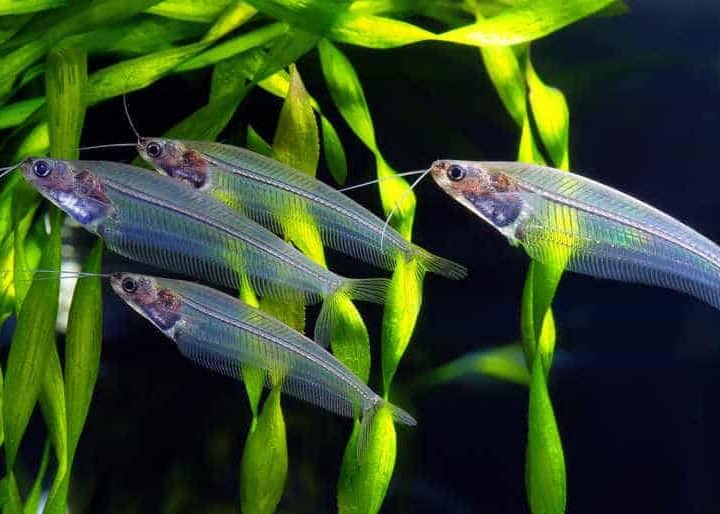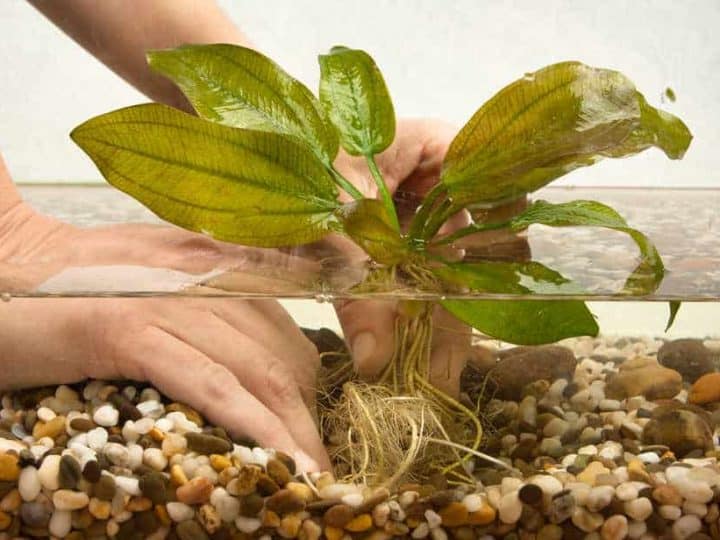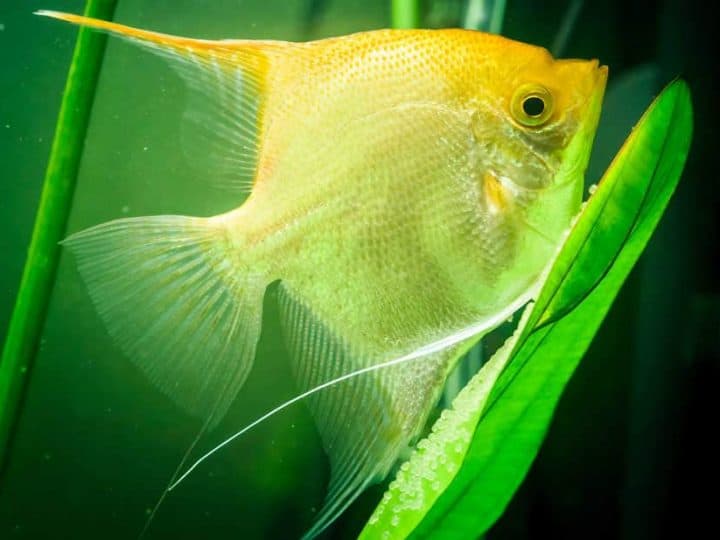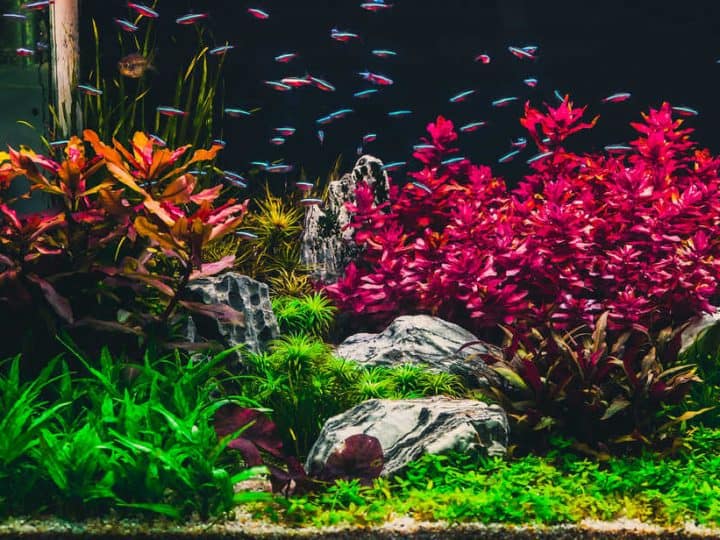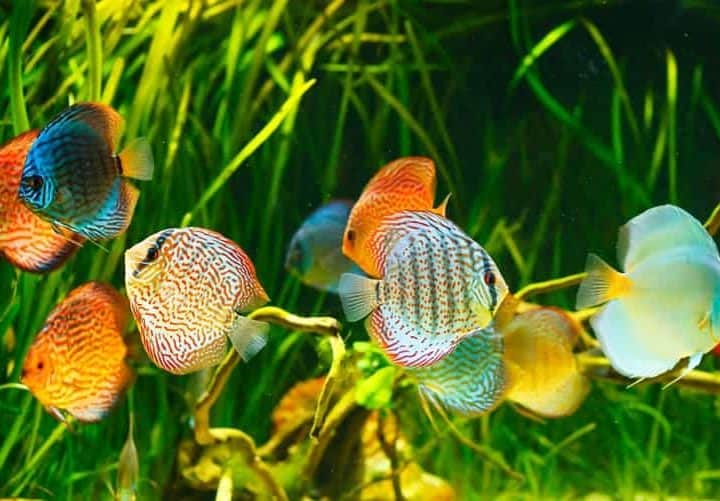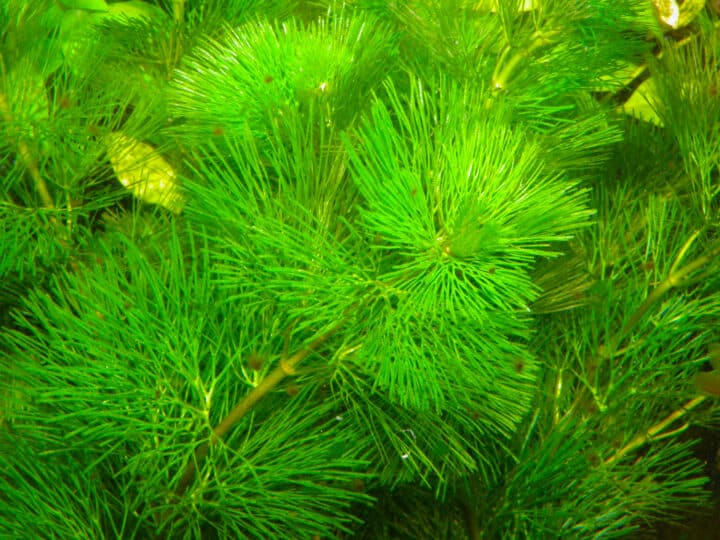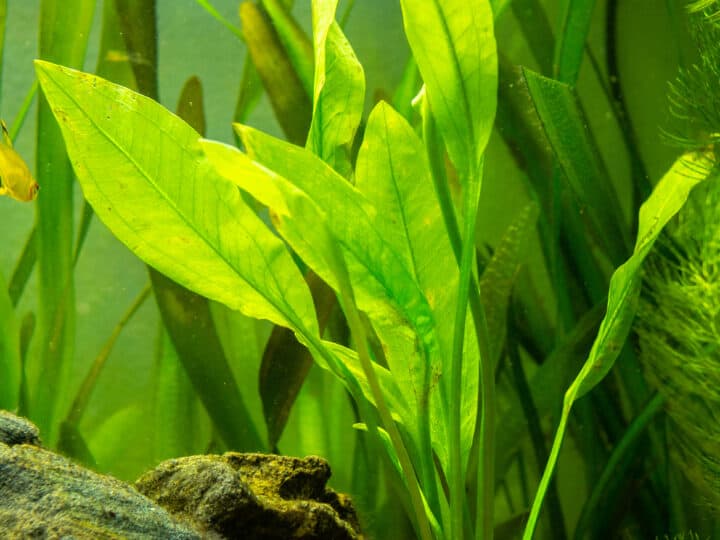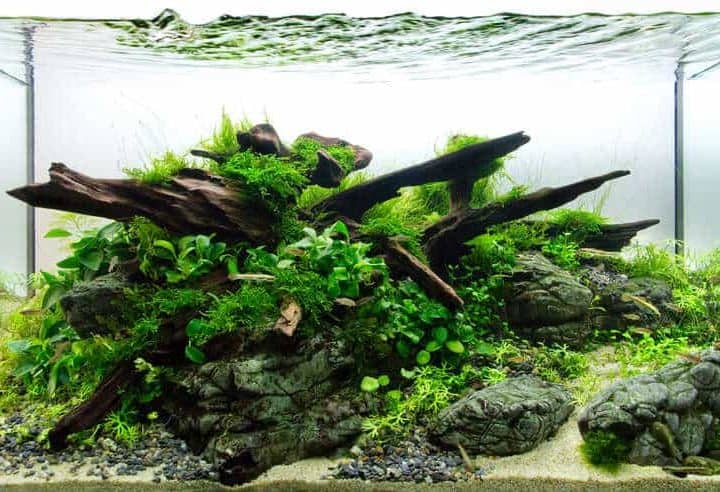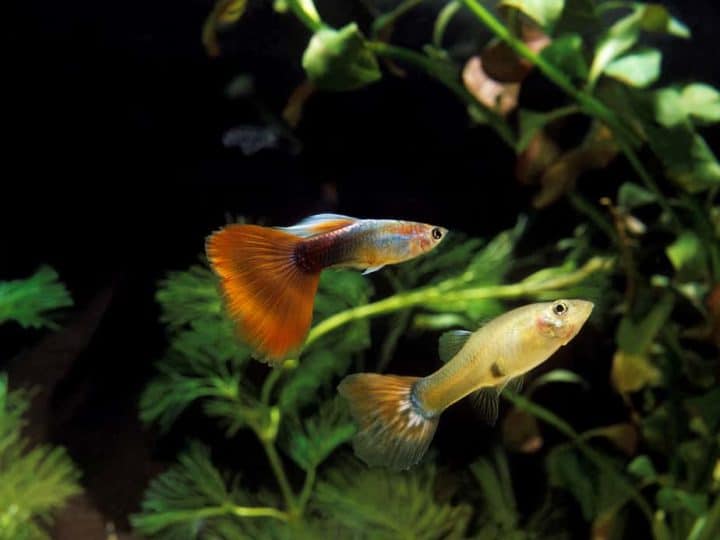Plants need light to survive and thrive in an underwater environment. However, not all plants have the same lighting requirements. In fact, some lower-maintenance plants will survive in lower levels of light. These types of plants, also known as low light plants, are the perfect starter flora for beginners who are new to planted aquariums!
Some people think you must spend a ton of money to have a tank full of plants. In actuality though, planted aquariums don’t have to be decked out with expensive equipment to look beautiful and lush. So if you don’t want to spend a ton of money on high tech lighting systems, you might want to try planting a low light aquarium plant.
I’ll be discussing six of these plants through the course of this article. The list starts a little bit further down, because I will first briefly go over how you can provide optimal care for these plants.
Live Plants and Lighting Needs
If you want your plant to flourish in its underwater environment, you need to have proper tank lighting. Light is the genesis of photosynthesis- a crucial biological process of self-feeding necessary for all plant-like organisms. In short when your plant has light it can feed itself and grow. Without light, your plant cannot take in nutrients and live in an aquarium.
Light is important, but you don’t want to give your plant the wrong amount of light. For instance, plants that are given too much light can wilt and die. Similarly, plants that are given too little light will be unable to grow to their full potential.
Not all plants are the same of course, so research is the best way to prevent early plant death. If you know how much light your plant needs, you won’t have to worry about killing it.
Luckily though, many of the low light plants on this list are more flexible with their lighting requirements. They only need a small amounts of light to grow in your tank, and some can handle a range of lighting setups and still survive. But we’ll get into this more later on in the post.
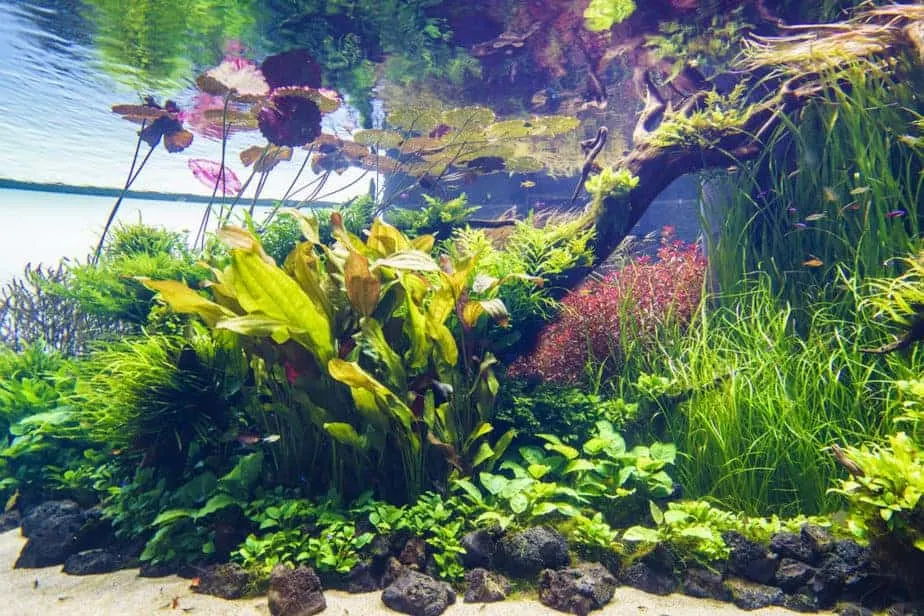
How To Care For Your Plants
Light is an essential part of plant care, but there is more to consider. If this is your first planted tank, you’ll need to keep a few care tips in mind. Remember, not all plants can be cared for in the same way. Each plant has specific requirements based on their species. And depending on the plant, maintenance can be easier or harder.
Luckily, low light plants are much easier to care for. Still, you want to take the time to research your plant and give it the best possible environment. In addition to giving the proper amount of light, make sure you are putting your plant in the right climate and pH level.
Also, look into substrates and fertilizers. Some plants will not need substrate and can be floated or attached to objects. Other plants might need to be buried in gravel or other material to root though. Fertilizer isn’t necessary for every plant, but it can really kickstart plants grow and keep your tank healthy.
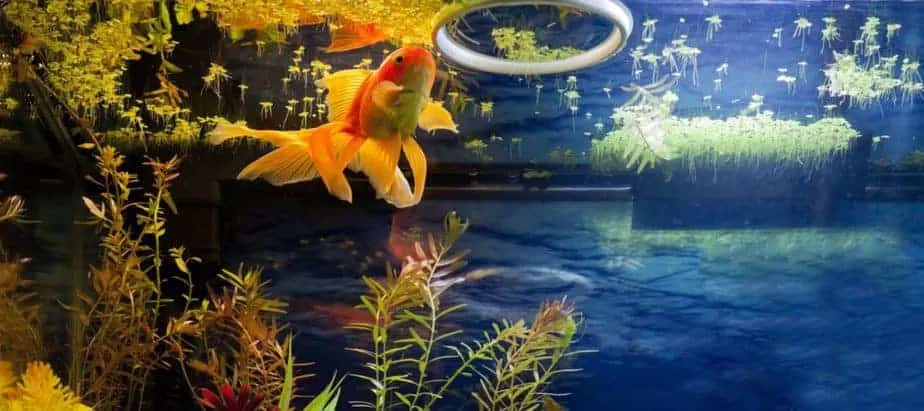
Along with this, I recommend looking at your plant foliage often. Specifically, be on the lookout for signs of rot. If your plant leaves are in bad condition, there is something wrong with your tank.
The water condition could be off, or maybe your plant isn’t getting enough nutrition. To fix this, make sure to get rid of decaying plant matter. This could potentially be polluting your tank water. To further prevent these issues, also prune your plants regularly, and do water changes often!
1. Bucephalandra
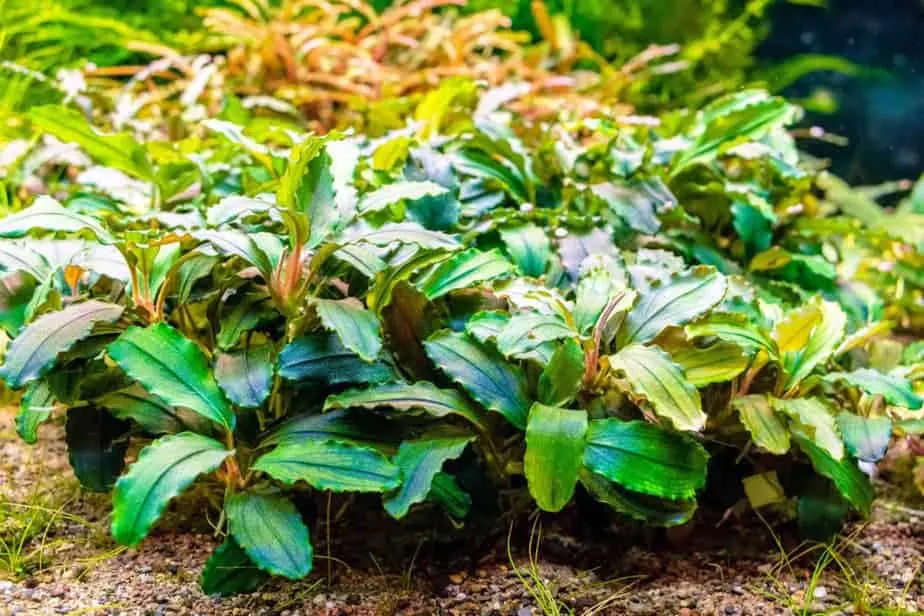
The first low light plant I will talk about is the Bucephalandra. Bucephalandra is a hardy species with over thirty different varieties. With the number of colors, sizes, and leave types, this has become an increasingly popular tank plant.
It takes a long time for this plant to grow fully, but Bucephalandra will flourish in almost any environment!
As a result, the maintenance of this rainforest flora is simple and bare-boned. You won’t need expensive substrates to ground this plant.
A solid object should be enough to get it rooted firmly. Typically, the Bucephalandra is found growing on rock and driftwood in streams or rivers. So you can add these items to your tank. Wood works fine for Bucephalandra, but a porous rock allows for the best possible plant rooting.
It shouldn’t come as much of a surprise, but Bucephalandra doesn’t require much to grow. Light can be kept low, and fertilizer does not have to be used. However, if you want a bigger and more colorful plant, you can up your light level, and add extra fertilizer. This will also increase the growing speed.
2. Java fern
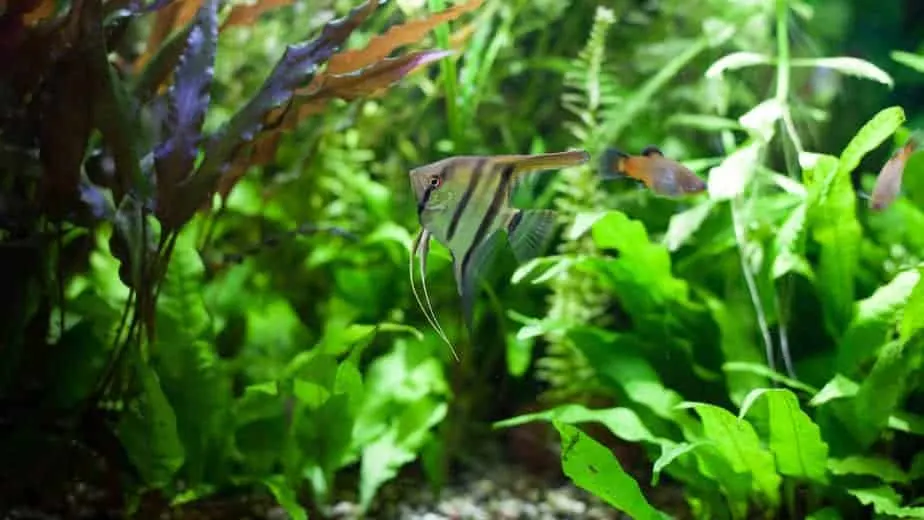
Java Ferns are highly favored within the fish keeping community. These low light plants offer tank owners versatility, great visual appeal, and simple maintenance. Java ferns are slow-growing plants, but with the right kind of care, they will create an ideal and naturalistic habitat for your pets.
With their long leaves and sturdy composition, any fish owner can benefit from this greenery. However, I especially recommend purchasing this plant if you are a beginner. With many plants, it’s easy to mess up the water conditions.
Java fern, on the other hand, can adapt to a number of environments. So you won’t have a hard time preparing your tank and getting your plant settled. Temperature requirements are less strict than other plants as well, and light requirements are low. Really, you can put this plant in any kind of tank setup, with almost any kind of fish.
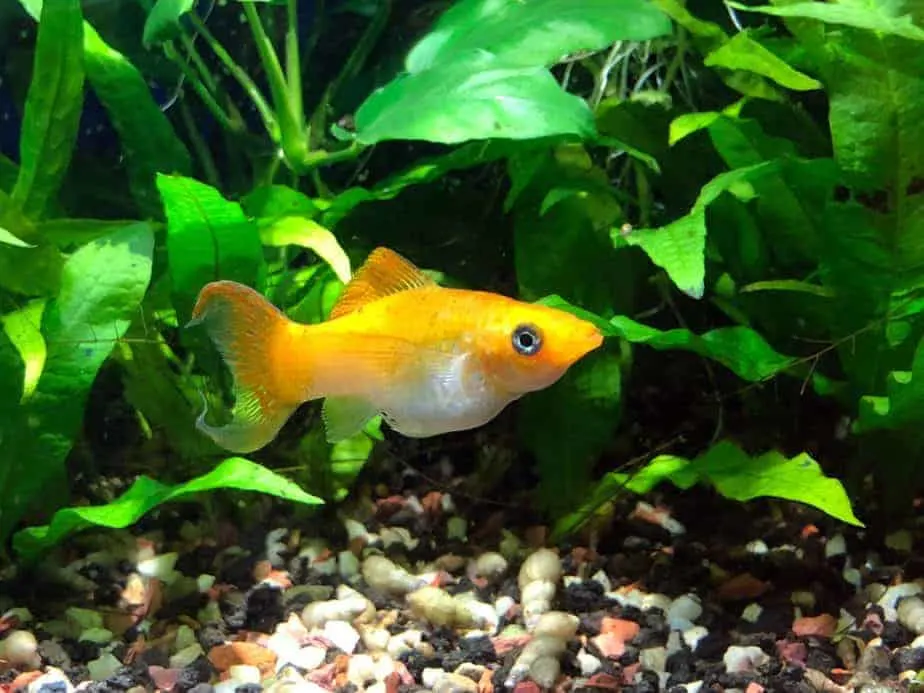
In addition, to being low maintenance, Java fern will save you a lot of money. Many plants need substrate and fertilizer to grow. Java Fern doesn’t require these products though. A substrate can be used, but I recommend attaching this plant to a decorative object to anchor it down. Preferably do not bury the roots of this plants as it could make the roots start to rot.
Fertilizer is optional as well, but if you want a bigger plant you can put some in your water. Because the plant is a slow grower, its nutrients requirements are slim.
If you do decide to use substrate, don’t cover the roots and bury them. This could stunt the growth of your plant, or even cause it to die. Alternatively, you could let the Java fern free- float, but how you choose to situate this versatile plant is up to you.
3. Java moss
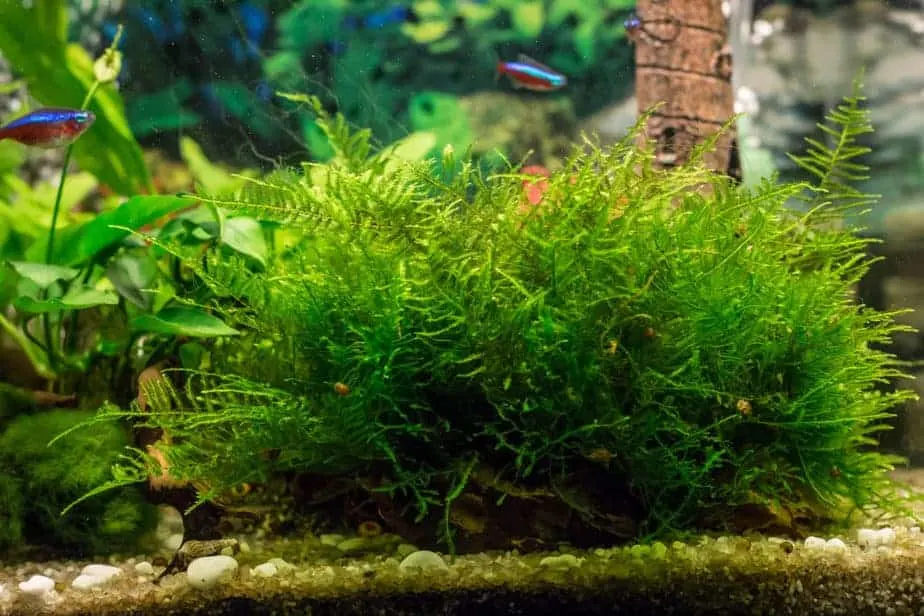
Java moss is another low light plant that beginners can grow with ease. This grass-like moss covers the expanse of your tank’s floor. And with fertilizer and the right growing conditions, it creates a lush and beautiful setting for fish. As a low light plant, less intense light is ideal for Java, but if you want to amplify your plant’s growth, more light can be shined on it.
Java plants have many of the same characteristics as Java Fern. In particular, they aren’t hard to manage, and they adapt well to several climates and conditions. But they also have some additional benefits for your tank’s ecosystem.
If you want a well-oxygenated tank you should definitely consider this plant. Java moss is great for your fish’s health and can help your pet breathe better. The large coverage of this moss also makes it an efficient filtration system.
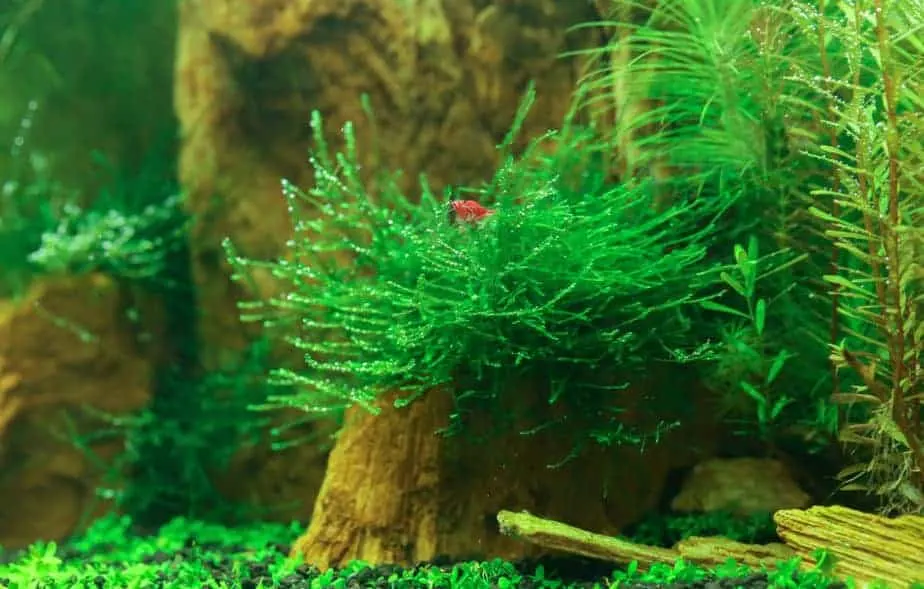
It’s not hard to get these effects going in your tank, just keep your tank clean. And when you put your moss in your tank try attaching it to some driftwood. You won’t have to use substrate, and you could just let the plant float, but an attachment surface creates better growth.
4. Anubias
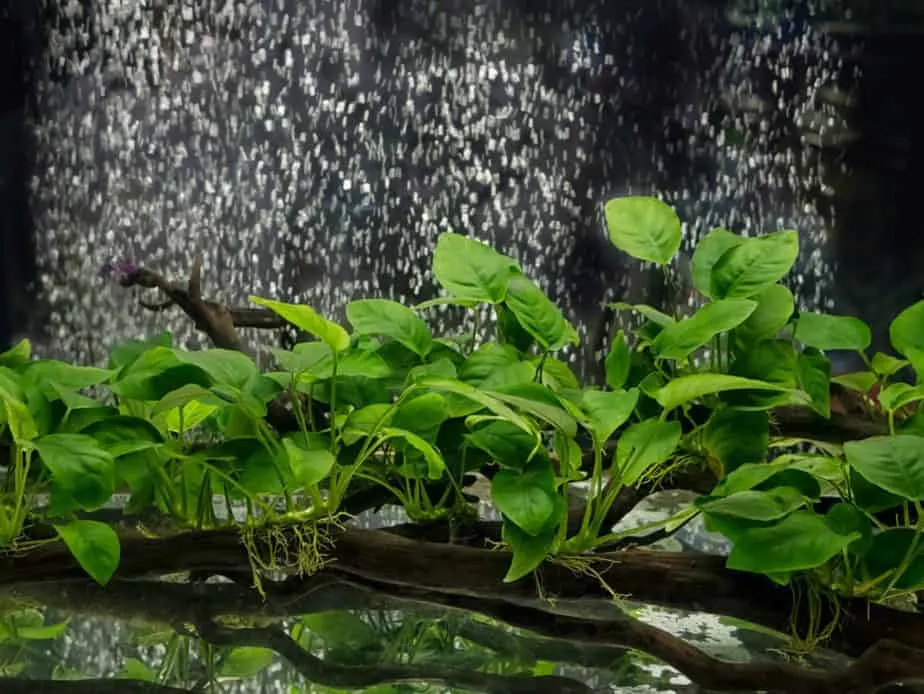
Anubias plants are native to streams and rivers in the African jungle region. These can be large tank plants that can grow up to a foot tall and wide. There are also smaller varieties. Depending on the size of your aquarium, try to pick a variety that suits your needs. A bigger one is called Anubias Barteri and a smaller leaved one is called Anubias Nana. These are two popular and available varieties.
Like the other plants on this list, you won’t have to make many adjustments to the climate or light in your setup. Anubias are tough plants that certainly do well in your aquarium.
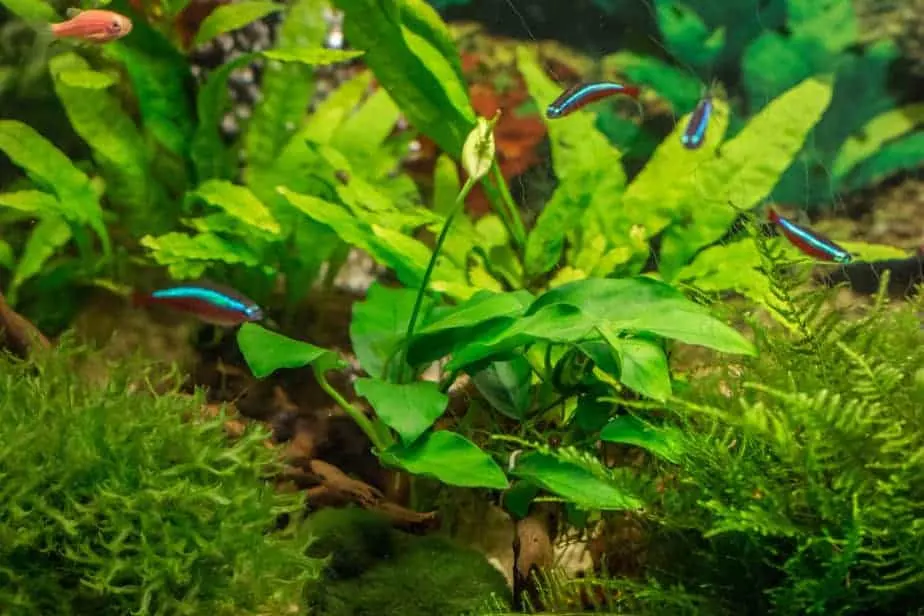
Low levels of light can be shined on your plant. But if you want a bigger plant moderate light can be used on Anubias plants as well. Larger Anubias can make a great centerpiece in your tank. So extra fertilizer and luminescence will only improve the look of your plant. You could trim your plant, but it won’t take over your tank overnight because they grow slowly.
In terms of placement, Anubias can be rooted in either gravel or driftwood. However, you want to be careful with your plant’s roots. If they are completely covered, your plant growth could suffer and the plant could die. Instead, I recommend not burying the roots of Anubias plants at all. It’s better to attach it to a piece of rock of driftwood.
5. Cryptocoryne
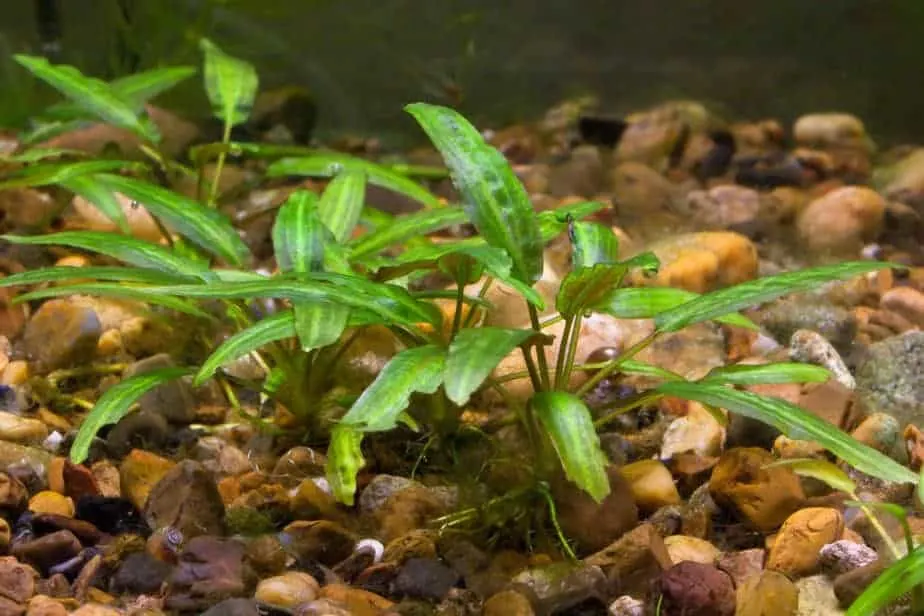
The tropical Cryptocoryne is an undemanding plant species, that comes in a few different colors and looks. Also known as crypts, this plant type is another popular low light specimen found in all kinds of environments and bodies of water in India.
While you won’t have much trouble caring for these plants, there are a few care tips to keep in mind. While some other low light plants can be placed in any light conditions, crypts do not do well in a lot of light. In fact, you could actually damage your plant with intense light.
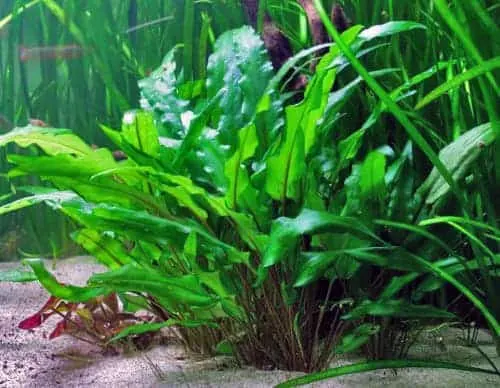
Keep the Crypt shaded or in low light, and make sure it is planted firmly. A substrate should be used for this plant if you want it to grow well. Sand or gravel should be fine. Fertilizers can be implemented in your substrate for faster growth too, but you can grow them without added nutrients.
When crypts are introduced to an aquarium, it will often look like they die within days. This is called “melting” and the plants just need time to recover. They “shed” their leaves and replace them with leaves suitable for living submerged. These plants are often grown emersed (out of the water).
6. Marimo moss ball
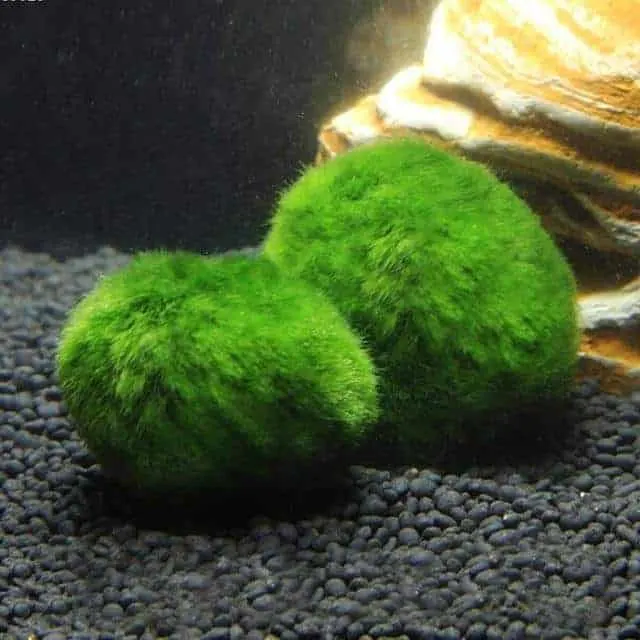
Marimo moss balls are the last low light plant on this list. If you’re looking for a simple no-hassle plant, this is your best option. Unlike other low light flora, you won’t have to worry about pruning or tank crowding. Marimo moss balls grow slow and maintain their size throughout their lifespan.
They are great tank fixtures for people who don’t know a lot about plants and don’t plan on having a fully planted aquarium. In short, you get many of the benefits found in other low light plants without any work. The moss balls aren’t actually made of moss though. They are packed tight with living algae that can help filter your tank.
Again, care is on the simple side with Marimo balls. Light levels should be fairly low. You can put the Mossballs in moderate light, but you don’t want them exposed to intense light, especially direct sunlight. They could wither this way.
You might have to clean moss balls occasionally, but this isn’t difficult. You merely rinse them and squeeze them out gently. Also make sure you turn them every time you do a water change, this way they can maintain their round shape.
Can low light plants grow with more light?
After reading this post, you’re probably wondering whether low light plants have to stay in low light. The answer depends on the plant. Still, many low light plants can be put in more intense levels of light. If you want to grow your plants bigger and more vibrant, more light can help with this. However, know that not all low light plants are the same. Some plants will die when placed under a lot of light. I mentioned this briefly when talking about certain specimens on the list.
Plants that are able to grow in low light are usually slow growing plants. This is also why its not always necessary to add additional fertilizers, because the plants don’t consume much and the fish in your aquarium could produce enough. If you add more light, the plants can grow quicker but need more nutrients and more CO2.
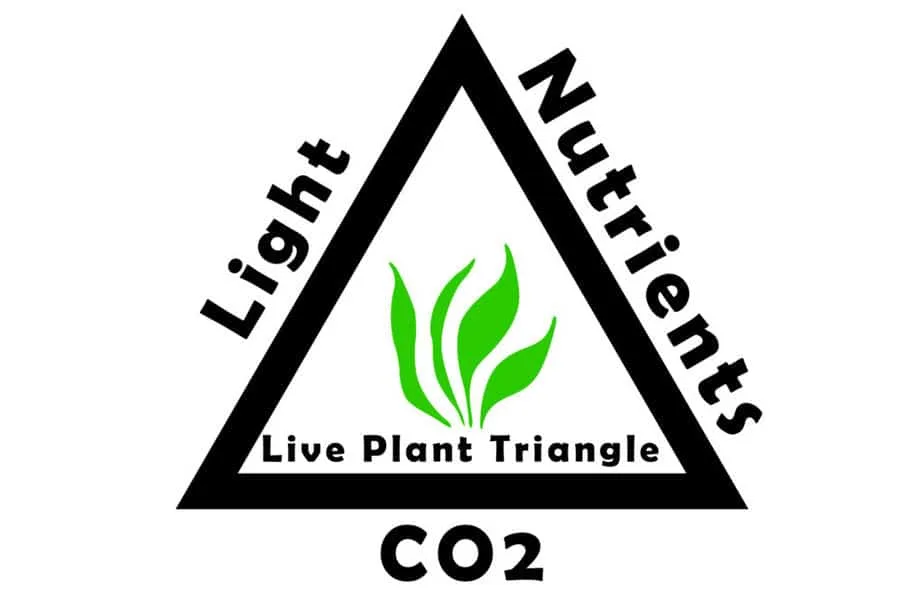
I’ve created this plant triangle that shows the needs of aquarium plants. The triangle needs to be balanced, so with little light you need little nutrients and little CO2, but the plant will grow slower. If you raise one, you should also raise the others!
Is adding fertilizer a must?
Another question relates to fertilizer. I talked about fertilizer a lot in the article, but in case it wasn’t clear, you can use these products on low light plants. In fact, fertilizer will only improve the quality of your flora. Still, for many of these plants, you don’t need to put fertilizer in the water to make them grow. You do need fertilizer if you want your plants to thrive though!

